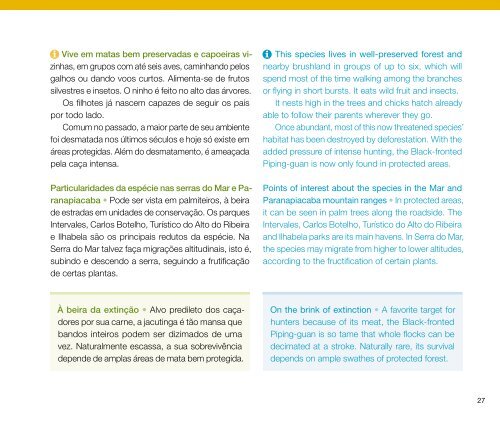Guia de aves Mata Atlântica Paulista - Secretaria do Meio Ambiente
Guia de aves Mata Atlântica Paulista - Secretaria do Meio Ambiente
Guia de aves Mata Atlântica Paulista - Secretaria do Meio Ambiente
You also want an ePaper? Increase the reach of your titles
YUMPU automatically turns print PDFs into web optimized ePapers that Google loves.
Vive em matas bem preservadas e capoeiras vi -<br />
zinhas, em grupos com até seis <strong>aves</strong>, caminhan<strong>do</strong> pelos<br />
galhos ou dan<strong>do</strong> voos curtos. Alimenta-se <strong>de</strong> frutos<br />
silvestres e insetos. O ninho é feito no alto das árvores.<br />
Os filhotes já nascem capazes <strong>de</strong> seguir os pais<br />
por to<strong>do</strong> la<strong>do</strong>.<br />
Comum no passa<strong>do</strong>, a maior parte <strong>de</strong> seu ambiente<br />
foi <strong>de</strong>smatada nos últimos séculos e hoje só existe em<br />
áreas protegidas. Além <strong>do</strong> <strong>de</strong>smatamento, é ameaçada<br />
pela caça intensa.<br />
Particularida<strong>de</strong>s da espécie nas serras <strong>do</strong> Mar e Pa -<br />
ranapiacaba • Po<strong>de</strong> ser vista em palmiteiros, à beira<br />
<strong>de</strong> estradas em unida<strong>de</strong>s <strong>de</strong> conservação. Os parques<br />
Intervales, Carlos Botelho, Turístico <strong>do</strong> Alto <strong>do</strong> Ribeira<br />
e Ilhabela são os principais redutos da espécie. Na<br />
Serra <strong>do</strong> Mar talvez faça migrações altitudinais, isto é,<br />
subin<strong>do</strong> e <strong>de</strong>scen<strong>do</strong> a serra, seguin<strong>do</strong> a frutificação<br />
<strong>de</strong> certas plantas.<br />
This species lives in well-preserved forest and<br />
near by brushland in groups of up to six, which will<br />
spend most of the time walking among the branches<br />
or flying in short bursts. It eats wild fruit and insects.<br />
It nests high in the trees and chicks hatch already<br />
able to follow their parents wherever they go.<br />
Once abundant, most of this now threatened species’<br />
habitat has been <strong>de</strong>stroyed by <strong>de</strong>forestation. With the<br />
ad<strong>de</strong>d pressure of intense hunting, the Black-fronted<br />
Piping-guan is now only found in protected areas.<br />
Points of interest about the species in the Mar and<br />
Paranapiacaba mountain ranges • In protected areas,<br />
it can be seen in palm trees along the roadsi<strong>de</strong>. The<br />
Intervales, Carlos Botelho, Turístico <strong>do</strong> Alto <strong>do</strong> Ribeira<br />
and Ilhabela parks are its main havens. In Serra <strong>do</strong> Mar,<br />
the species may migrate from higher to lower altitu<strong>de</strong>s,<br />
according to the fructification of certain plants.<br />
À beira da extinção • Alvo predileto <strong>do</strong>s caça<strong>do</strong>res<br />
por sua carne, a jacutinga é tão mansa que<br />
ban<strong>do</strong>s inteiros po<strong>de</strong>m ser dizima<strong>do</strong>s <strong>de</strong> uma<br />
vez. Naturalmente escassa, a sua sobrevivência<br />
<strong>de</strong>pen<strong>de</strong> <strong>de</strong> amplas áreas <strong>de</strong> mata bem protegida.<br />
On the brink of extinction • A favorite target for<br />
hunters because of its meat, the Black-fronted<br />
Piping-guan is so tame that whole flocks can be<br />
<strong>de</strong>cimated at a stroke. Naturally rare, its survival<br />
<strong>de</strong>pends on ample swathes of protected forest.<br />
27

















